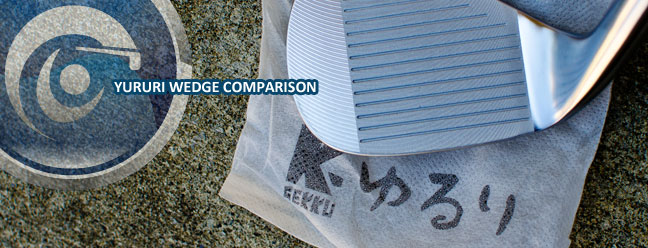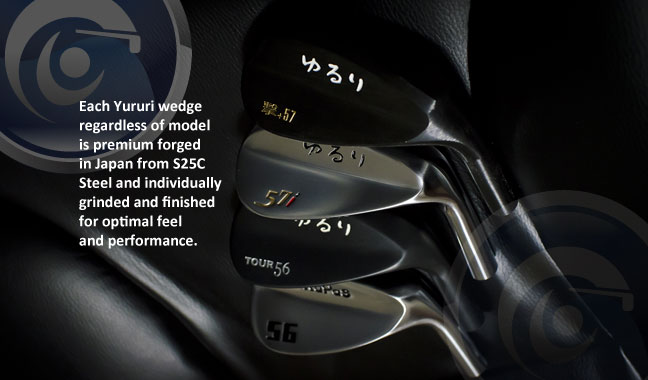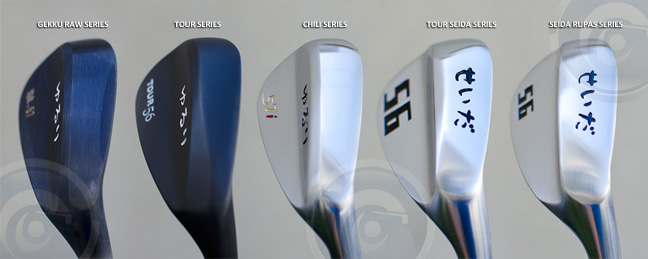Today I’m going to look more closely at Keigekiku Yururi’s current wedge lineup. As you may have seen on the blog a few weeks ago, I covered the different forged irons which offer a bit of something for everyone. The wedge line is much of the same, with top quality forgings, designs and performance for a variety of players. This post will look more at the visual design of each model and compare they side by side.
The current Yururi lineup includes the Gekku Raw Wedge (non conforming grooves), the Tour Wedge (in both conforming and non conforming grooves), the Chili Wedge (conforming grooves), the Tour Seida Wedge (non conforming grooves) and the Seida Rupas wedge (conforming grooves). Every model is an original design forged from premium S25C steel in Himeji and each head individually grinded and finished. They all show superb workmanship and on the model like the Gekku Raw which is unplated and unfinished you can really see the skills of the grinders at work (see the post I made on the Gekku Raw).
All the pictures below can be clicked on to pop up a larger image for your viewing pleasure. It can be hard to squeeze in the comparison pics when our blog is limited to 648 pixels in its content column.
General size and shape…
When first comparing the Yururi models side by side you’ll notice that size wise, they are not that different from one another. while they are not ultra compact, Yururi wedges are on the smaller side which will appeal to better players. Size aside, the differences like in the grinds, and designs of each head as well as the overall shapes and finish. All 5 models are superb looking and from an aesthetics standpoint quite attractive. The Gekku Raw and Tour Models (silver paintfill for non conforming and gold for conforming) are both finished in black with the Gekku being dyed black and the Tour a flat black. The Chili and both Seida wedges are plated and satin in finish.
Face Profiles…
From the face profiles, you can see that the Gekku, Tour and Chili are tear drop shaped heads while the Seida models are rounder, especially the Rupas. The head shapes actually go hand in hand with the grinds and while all 5 models are versatile, they do excel in certain conditions which I’ll talk about below with the grinds. Typically a tear drop shape allows for more mass towards the toe which also raises the CG away from the hosel and creates a stronger heavier spin ball. It also promotes the better player, when opening up the wedge to utilize the full length of the face for more spin control. The Seidas have a larger face area for slightly more ease of use and confidence at address.
At Address…
Here again at address you can see how the Seida Rupas is more rounded and the raw black face provides a nice target for the increased impact area. All Yururi wedges have reasonably thin top lines and pretty small offset, the older non conforming Tour Seida has the most offset while the Gekku, Tour, Chili and Rupas are all quite close in offset numbers. Being raw, the Gekku has the sharpest grooves and this is one of the reasons why the Gekku’s 41 and 45* lofts are very popular as golfers purchase them to replace 8, 9 and PW irons for much superior spin and stopping power. The Seida Tour which is also non conforming may have the most bite due to a very aggressive face milling.
Sole and Grind…
The top images shows a side by side comparison of the grind and sole shape of each Yururi model. All 5 models have some degree of trailing edge, heel and leading edge relief to different extents which increase verastility. The Seida series feature a wider and rounder sole which helps it suit lusher courses and provide a bit more forgiveness. The Gekku, Tour and Chili have narrower soles making them very versatile for different conditions and in tight lies and especially excelling in harder conditions. The heel relief is the largest on the Tour models allow the head to be completely opened up but still pointing at the target with its tear drop shape. As mentioned above when comparing head shapes, the sole matches the face in creating maximum spin control and direction. The largest amount of leading edge relief is on the leading edge grind of the Gekku Raws and this helps it dig less even though the sole is rather narrow. Bounce varies on all the models and there is really quite a variety of bounce to match different swing styles. The Chili model actually has the most to choose from with the number of Chilis representing the amount of bounce ie 1 chili = low to mid bounce, 2 chilis = medium to high bounce, 3 chilis =very high bounce.
In the end Yururi has 5 great wedges that all look and feel wonderful and are grinded and designed with top performance in mind. Like the Yururi irons, there is a Yururi wedge for everyone and all different kind of swings and conditions. As always you can find all the Yururi clubs in the pro shop and if you need advice or custom quotes (Yururi can be built with any shaft and grip to spec), please feel free to email us.

















